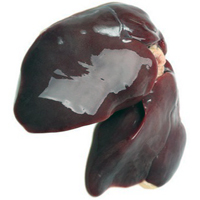Determination of heavy metals and selenium content in chicken liver at Erbil city, Iraq

Accepted: 19 March 2020
HTML: 40
All claims expressed in this article are solely those of the authors and do not necessarily represent those of their affiliated organizations, or those of the publisher, the editors and the reviewers. Any product that may be evaluated in this article or claim that may be made by its manufacturer is not guaranteed or endorsed by the publisher.
Authors
Heavy metal contamination of poultry meat is a critical issue for human health due to associated risks of cytotoxicity and systemic pathologies after ingestion of such metals. A total of twenty chicken liver samples were collected from markets of Erbil city and analyzed for ten heavy metals contents by Inductively Coupled Plasma Optical Emission Spectrometry. The targeted metals were cadmium (Cd), cobalt (Co), chromium (Cr), copper (Cu), manganese (Mn), nickel (Ni), lead (Pb), mercury (Hg), zinc (Zn) and selenium (Se). The average concentrations (mg/kg) of targeted trace elements were 0.06±0.027, 0.06±0.05, 2.05±0.34, 1.85±0.47, 0.15±0.17, and 33.53±5.24 for Co, Cr, Cu, Mn, Ni, and Zn respectively. Copper (Cu) levels significantly exceeded the maximum permissible limit of WHO. Moreover, the average concentrations of toxic heavy metals and selenium were 0.07±0.037, 0.278±0.10, 0.11±0.083, and 2.01±0.454 mg/kg for Cd, Pb, Hg, and Se respectively. Hg and Pb levels exceeded the permissible limits of WHO. Higher levels of Cu and Hg in poultry may pose a serious threat to consumers which demand countermeasures and precautions to be taken. Iraqi Standards Authority and relevant official institutions are strongly recommended to regulate safe disposal of heavy metal waste in the environment to reduce animal exposure to such metals.
How to Cite
PAGEPress has chosen to apply the Creative Commons Attribution NonCommercial 4.0 International License (CC BY-NC 4.0) to all manuscripts to be published.

 https://doi.org/10.4081/ijfs.2020.8659
https://doi.org/10.4081/ijfs.2020.8659



